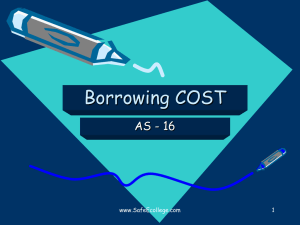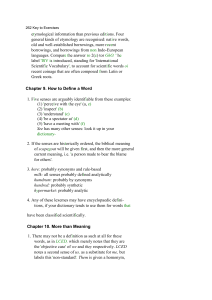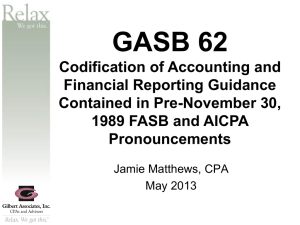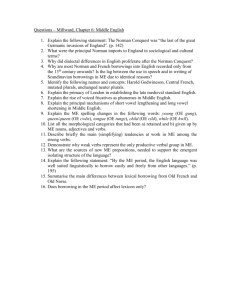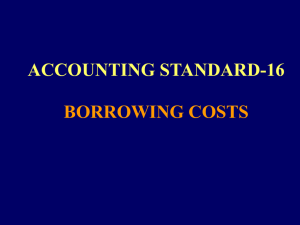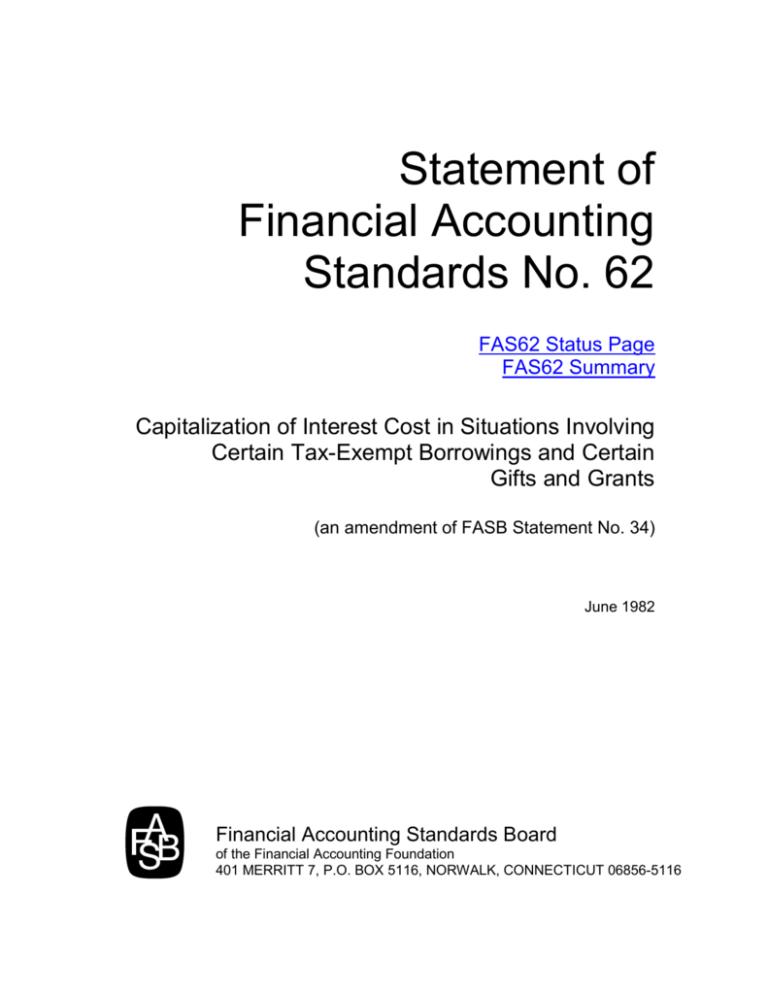
Statement of
Financial Accounting
Standards No. 62
FAS62 Status Page
FAS62 Summary
Capitalization of Interest Cost in Situations Involving
Certain Tax-Exempt Borrowings and Certain
Gifts and Grants
(an amendment of FASB Statement No. 34)
June 1982
Financial Accounting Standards Board
of the Financial Accounting Foundation
401 MERRITT 7, P.O. BOX 5116, NORWALK, CONNECTICUT 06856-5116
Copyright © 1982 by Financial Accounting Standards Board. All rights reserved. No
part of this publication may be reproduced, stored in a retrieval system, or transmitted, in
any form or by any means, electronic, mechanical, photocopying, recording, or
otherwise, without the prior written permission of the Financial Accounting Standards
Board.
Page 2
Statement of Financial Accounting Standards No. 62
Capitalization of Interest Cost in Situations Involving Certain Tax-Exempt
Borrowings and Certain Gifts and Grants
an amendment of FASB Statement No. 34
June 1982
CONTENTS
Paragraph
Numbers
Introduction ................................................................................................................. 1– 2
Standards of Financial Accounting and Reporting: .................................................... 3– 9
Amendments to FASB Statement No. 34.............................................................. 5– 7
Rescission of Technical Bulletin................................................................................ 8
Effective Date and Transition..................................................................................... 9
Appendix A: Example of Application of This Statement ............................................. 10
Appendix B: Basis for Conclusions ........................................................................ 11–19
Page 3
FAS 62: Capitalization of Interest Cost in Situations Involving
Certain Tax-Exempt Borrowings and Certain Gifts and Grants
an amendment of FASB Statement No. 34
FAS 62 Summary
This Statement amends FASB Statement No. 34, Capitalization of Interest Cost, (a) to
require capitalization of interest cost of restricted tax-exempt borrowings less any interest earned
on temporary investment of the proceeds of those borrowings from the date of borrowing until
the specified qualifying assets acquired with those borrowings are ready for their intended use
and (b) to proscribe capitalization of interest cost on qualifying assets acquired using gifts or
grants that are restricted by the donor or grantor to acquisition of those assets.
INTRODUCTION
1.
The FASB has received a number of requests to reconsider the issue of offsetting interest
income against interest cost in the application of FASB Statement No. 34, Capitalization of
Interest Cost, for purposes of determining either capitalization rates or limitations on the amount
of interest to be capitalized. FASB Technical Bulletin No. 81-5, Offsetting Interest Cost to Be
Capitalized with Interest Income, states that Statement 34 does not permit such offsetting. Other
requests have been received to consider the issue of capitalization of interest cost in situations in
which qualifying assets are acquired using gifts and grants restricted to the purchase of the
specified assets.
2.
The Board has concluded that Statement 34 should be amended to require offsetting of
interest income against interest cost in certain circumstances involving tax-exempt borrowings
that are externally restricted as specified in paragraph 3. Those situations include many
governmental borrowings and most governmentally sponsored borrowings (such as industrial
revenue bonds and pollution control bonds). In such situations, interest earned generally is
considered in and is significant to the initial decision to acquire the asset, and the capitalization
of net interest cost provides a better measure of the entity's net investment in the qualifying
Copyright © 1982, Financial Accounting Standards Board
Not for redistribution
Page 4
assets. The Board believes that in those circumstances the association is direct and the funds
flows from borrowing, temporary investment, and construction expenditures are so intertwined
and restricted as to require accounting for the total net cost of financing as a cost of the
qualifying assets. The Board also concluded that in all other situations offsetting of interest
income against interest cost is not appropriate. The Board further concluded that qualifying
assets acquired with externally restricted gifts or grants should not be subject to capitalization of
interest cost under Statement 34.
STANDARDS OF FINANCIAL ACCOUNTING AND REPORTING
3.
Interest earned shall not be offset against interest cost in determining either capitalization
rates or limitations on the amount of interest cost to be capitalized except in situations involving
acquisition of qualifying assets financed with the proceeds of tax-exempt borrowings if those
funds are externally restricted to finance acquisition of specified qualifying assets or to service
the related debt.
4.
The amount of interest cost capitalized on qualifying assets acquired with proceeds of
tax-exempt borrowings that are externally restricted as specified in paragraph 3 shall be all
interest cost of the borrowing less any interest earned on related interest-bearing investments
acquired with proceeds of the related tax-exempt borrowings 1 from the date of the borrowing
until the assets are ready for their intended use. Interest cost of a tax-exempt borrowing shall be
eligible for capitalization on other qualifying assets of the entity when the specified qualifying
assets are no longer eligible for interest capitalization.
Amendments to FASB Statement No. 34
5.
The following subparagraph is added to paragraph 10 of Statement 34, which specifies the
types of assets for which interest is not capitalized:
f. Assets acquired with gifts and grants that are restricted by the donor or grantor to
acquisition of those assets to the extent that funds are available from such gifts and
grants. Interest earned from temporary investment of those funds that is similarly
restricted shall be considered an addition to the gift or grant for this purpose.
6.
The following footnote is added at the end of the first sentence of paragraph 13 of
Statement 34, which deals with determining the amount of interest cost to be capitalized:
*If qualifying assets are financed with the proceeds of tax-exempt borrowings and those
funds are externally restricted to the acquisition of specified qualifying assets or to
service the related debt, the amount of interest cost capitalized shall be determined in
accordance with FASB Statement No. 62, Capitalization of Interest Cost in Situations
Copyright © 1982, Financial Accounting Standards Board
Not for redistribution
Page 5
Involving Certain Tax-Exempt Borrowings and Certain Gifts and Grants.
7.
The following footnote is added to paragraph 17 of Statement 34, which specifies the
period for interest capitalization:
*In situations involving qualifying assets financed with the proceeds of tax-exempt
borrowings that are externally restricted as specified in Statement 62, the capitalization
period begins at the date of the borrowing.
Rescission of Technical Bulletin
8.
FASB Technical Bulletin No. 81-5, Offsetting Interest Cost to Be Capitalized with Interest
Income, is rescinded upon issuance of this Statement.
Effective Date and Transition
9.
This Statement shall be effective for tax-exempt borrowing arrangements entered into and
gifts or grants received after August 31, 1982, with earlier application encouraged in financial
statements that have not been previously issued. This Statement may be, but is not required to
be, applied retroactively to previously issued financial statements for fiscal years beginning after
December 15, 1979. If previously issued financial statements are restated, the financial
statements shall, in the year that this Statement is first applied, disclose the nature of any
restatement and its effects on income before extraordinary items, net income, and related per
share amounts for each restated year presented.
The provisions of this Statement need
not be applied to immaterial items.
This Statement was adopted by the affirmative votes of four members of the Financial
Accounting Standards Board. Messrs. Block, Morgan, and Walters dissented.
Mr. Block does not support this standard because it merges the accounting for three
dissimilar business activities into one: the borrowing of funds, the temporary investment of
funds, and the acquisition of capital assets. Users of financial statements find it useful to
calculate rates of return to providers of capital, such as return on equity, return on long-term
capital, and return on total capital, as well as returns on various types of investment assets and
operating assets. Under this standard, interest income will not be reported as a return on the
investment asset, interest expense will not be reported as a return on borrowed funds, and a net
amount of interest expense or income will be amortized over the life of a fixed asset as
depreciation rather than recognized currently as interest. This obscures information significant
to users, particularly to those who look upon depreciation as a return of capital, interest cost as a
return on capital, and interest income as a return on a financial asset. In addition, this standard
Copyright © 1982, Financial Accounting Standards Board
Not for redistribution
Page 6
calls for an unwarranted extension of the capitalization period to include a period when no
acquisition activities are under way, contrary to two of the three requirements of paragraph 17 of
Statement 34. The extension of the capitalization period is defended (paragraphs 2 and 14 of this
Statement) on grounds that the investment and financing activities are generally considered in
the decision to acquire the asset. Mr. Block believes that accounting should reflect the nature
and circumstances of transactions and not the unverifiable motivations and expectations that led
to them. He doubts that the deferred net interest credit generated during the preacquisition
period meets the definition of any element other than revenue as set forth in FASB Concepts
Statement No. 3, Elements of Financial Statements of Business Enterprises, and is troubled by
the possibility that in extreme cases the acquired asset could be carried at a negative cost.
Mr. Morgan and Mr. Walters believe that offsetting related interest income and expense
during the acquisition period is appropriate and consistent with the avoidable-interest-cost notion
that is embodied in Statement 34. They disagree with this Statement, however, because it
restricts offsetting to tax-exempt borrowings. In their opinion, the reasoning for this narrow
approach is based on a conclusion that only the tax-exempt situations are so closely intertwined
with the asset acquisition as to require association when, in all likelihood, such intertwining may
exist regardless of the tax status of the borrowings. In addition, they believe that it is
inconsistent to view the borrowings as intertwined with the asset during the capitalization period
and as part of the pool of fungible funds from which interest is available for capitalization on
other assets after the capitalization period.
Members of the Financial Accounting Standards Board:
Donald J. Kirk, Chairman
Frank E. Block
John W. March
Robert A. Morgan
David Mosso
Robert T. Sprouse
Ralph E. Walters
Copyright © 1982, Financial Accounting Standards Board
Not for redistribution
Page 7
Appendix A: EXAMPLE OF APPLICATION OF THIS STATEMENT
10. The following example illustrates the application of this Statement in the situation
described below:
a.
b.
c.
d.
e.
f.
The entity is committed to construct Project A at a cost of $10 million. Project A is to be
financed from three sources:
(1) $4 million government grant restricted to use for the specified construction project,
payable $1 million per year
(2) $4 million tax-exempt borrowing at an interest rate of 8 percent ($320,000 per year)
(3) $2 million from operations
The entity has $10 million in other borrowings that are outstanding throughout the
construction of Project A. The interest rate on those borrowings is 6 percent. Other
qualifying assets of the entity never exceed $5 million during the construction of Project A.
The proceeds from the borrowing and the initial phase of the grant are received 1 year in
advance of starting construction on Project A and are temporarily invested in
interest-bearing investments yielding 12 percent. Interest income earned from temporary
investments is not reinvested.
Project A will take 4 years after start of construction to complete.
The following table sets forth the amount of interest to be capitalized as part of the entity's
investment in Project A.
Over the course of construction the net cost of financing is $678,000, the sum of the interest
capitalized for the 5 years. Accordingly, the entity's total net investment in Project A will be
$10,678,000.
Copyright © 1982, Financial Accounting Standards Board
Not for redistribution
Page 8
Year__________________
19X3
19X4
(amounts in thousands)
19X1
19X2
(1) Assumed average
qualifying assets
$
0
$2,000
$5,000
$8,000
$9,000
(2) Average funding received
borrowing
grant
4,000
1,000
4,000
2,000
4,000
3,000
4,000
4,000
4,000
4,000
(3) Average temporary
investments
((2) – (1), not less
than zero)*
borrowing
grant
4,000
1,000
3,000
1,000
1,000
1,000
0
0
0
0
(4) Interest earned
((3) x 12 percent)
(a) borrowing
(b) grant
480
120
360
120
120
120
0
0
0
0
(5) Average qualifying
assets in excess of
borrowing, grant,
and interest earned
on grant †
0
0
0
0
640
(6) Interest cost
capitalized—
other borrowings
((5) x 6 percent)
0
0
0
0
38
320
320
320
320
320
(160)
(40)
200
320
358
(7) Interest cost—
tax-exempt borrowings
(8) Interest capitalized
((6) + (7) –
(4)(a)) ‡
19X5
_____________
*Balances of unexpended borrowings and unexpended grants can vary depending on the source from
which the entity elects to disburse funds.
†That is, (1) average qualifying assets minus the sum of ((2) average funding received plus (4)(b)
cumulative interest earned on grant), not less than zero.
‡ Note that amounts in parentheses are reductions in the cost of the asset.
Copyright © 1982, Financial Accounting Standards Board
Not for redistribution
Page 9
Appendix B: BASIS FOR CONCLUSIONS
11. An Exposure Draft of a proposed Statement, Capitalization of Interest Cost in Situations
Involving Tax-Exempt Borrowings and Certain Gifts and Grants, was issued on December 22,
1981. The Board received 94 letters of comment in response to the Exposure Draft. This
appendix discusses the factors that the Board considered significant in reaching the conclusions
in this Statement. The Board members who assented to this Statement did so on the basis of the
overall considerations. Individual Board members gave greater weight to some factors than to
others.
Tax-Exempt Borrowings
12. Many respondents recommended that offsetting interest income against interest expense
be extended to situations in addition to tax-exempt borrowings. They believe that the tax status
of the borrowings should not determine the accounting and that offsetting should be required in
situations that involve borrowings that are externally restricted for use on particular projects
specified under the terms of the borrowing agreement and that externally restrict the interest on
temporary investment of the proceeds to finance construction or service the related debt. They
believe that the association of such borrowings with the specified projects is direct and that
offsetting is appropriate under those circumstances.
13. Some respondents stated that interest income earned prior to acquisition or construction is
related to investment decisions and not to acquisition decisions. They would not offset the
interest earned for the period from the date of the borrowing to the beginning of the acquisition
period even in situations involving tax-exempt borrowings.
14. Statement 34 requires that interest cost be capitalized only on funds that actually have
been expended in the process of acquiring a qualifying asset. Obviously, those expended funds
cannot be earning interest income. Identifying a borrowing with a specific acquisition and
requiring that interest income be offset against interest cost in determining the amount of interest
to be capitalized necessarily involves extending the beginning of the capitalization period from
the date actual expenditures are made to the date of the borrowing. The Board does not believe
that extending the capitalization period in that way and thereby generally increasing the amount
of capitalized interest is appropriate. As stated in paragraph 6 of Statement 34, "the historical
cost of acquiring an asset includes the costs necessarily incurred to bring it to the condition and
location necessary for its intended use." Borrowing for indeterminate periods in advance of
actual expenditures cannot be said generally to be a necessary part of acquiring an asset. The
Board is persuaded, however, that an exception should be made in the case of tax-exempt
borrowings specified by this Statement. The timing and use of tax-exempt borrowings are
generally an integral part of the decision to acquire the related asset, and the net interest cost
Copyright © 1982, Financial Accounting Standards Board
Not for redistribution
Page 10
from the date of borrowing to the time the acquired asset is substantially complete and ready for
its intended use is an essential part of the cost of acquiring that asset.
15. Some respondents questioned the appropriateness of a net reduction in the cost of an asset
that may occur if the interest earned from the date of borrowing is greater than the interest
accrued on the debt during the capitalization period. The Board believes, for the reasons
indicated in paragraph 14, that interest earned on the temporary investment of the proceeds of
certain tax-exempt borrowings from the date of borrowing until the specified qualifying assets
are ready for their intended use is a part of the net cost of financing that is properly included as a
cost of the qualifying asset. This may result in a net reduction in the cost of an asset.
16. Some respondents stated that interest cost of a tax-exempt borrowing should not be
eligible for capitalization on other qualifying assets of the entity if the specified qualifying asset
is no longer eligible for capitalization. They believe that this conflicts with the notion of specific
association between the tax-exempt borrowings and the assets acquired and that the initial
association of the borrowing with the qualifying asset nullifies subsequent capitalization of
interest cost of the borrowing. The Board believes that the avoidable-interest concept explained
in paragraph 12 of Statement 34 requires that interest cost of tax-exempt borrowings be eligible
for capitalization on other qualifying assets acquired after completion of the specified qualifying
assets. For the same reason, the interest cost on funds provided from the tax-exempt borrowings
that are not designated for the acquisition of qualifying assets and servicing the related debt
during the capitalization period are eligible for capitalization on other qualifying assets.
Gifts and Grants
17. Nearly all of the respondents who commented on the proposed treatment for qualifying
assets acquired with a restricted gift or grant and for interest earned on the temporary investment
of those funds supported the Exposure Draft. They believe that qualifying assets acquired with
restricted gifts and grants should not be subject to capitalization of interest cost under Statement
34 because they believe there is no economic cost of financing associated with a gift or grant.
They believe such an exemption is appropriate only if the gift or grant is restricted by the donor
or grantor to the acquisition of the specified asset (or otherwise required to be returned to the
donor or grantor). Accordingly, they would capitalize no interest cost during the acquisition of
the qualifying asset to the extent that funds are available from such gifts and grants. They would
also consider restricted interest earned from temporary investment of the gift or grant as an
enhancement to and consequently an integral part of the gift or grant. The Board concurred and
has adopted those provisions of the Exposure Draft.
Transition
18. Some respondents requested that the transition provisions of the Exposure Draft be
modified to permit retroactive application. They believe that permitting retroactive application
would enable enterprises to eliminate problems of lack of comparability resulting from applying
Copyright © 1982, Financial Accounting Standards Board
Not for redistribution
Page 11
Statement 34 and Bulletin 81-5 that prohibit offsetting and the provisions of this Statement that
require offsetting. The Board concurred and has revised the transition provisions to permit
retroactive application to the effective date of Statement 34. Statement 34 was effective
prospectively for fiscal years beginning after December 15, 1979.
19. The Board concluded that it can reach an informed decision on the basis of existing
information without a public hearing and that the effective date and transition specified in
paragraph 9 are advisable in the circumstances.
Copyright © 1982, Financial Accounting Standards Board
Not for redistribution
Page 12
Footnote
FAS62, Footnote 1--The interest cost and interest earned on any portion of the proceeds of the
tax-exempt borrowings that are not designated for the acquisition of specified qualifying assets
and servicing the related debt are excluded. The entire interest cost on that portion of the
proceeds that is available for other uses (such as refunding of an existing debt issue other than a
construction loan related to those assets) is eligible for capitalization on other qualifying assets.
Copyright © 1982, Financial Accounting Standards Board
Not for redistribution
Page 13

